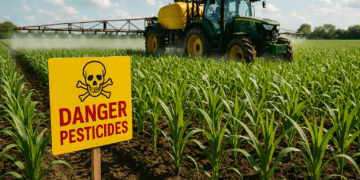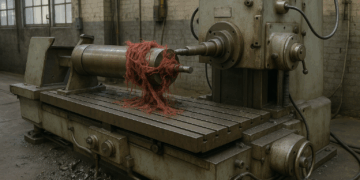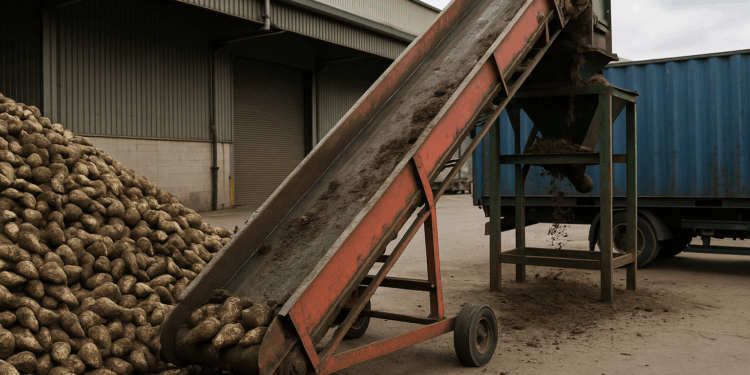Story Highlight
– Knowles Logistics fined £133,000 for safety violations.
– Employee injured after falling from sugar beet conveyor.
– Blockages required unsafe manual removal by employees.
– HSE found inadequate safety measures for clearing blockages.
– Falls from height are major workplace injury causes.
Full Story
A logistics firm based in Cambridgeshire has been ordered to pay a hefty fine of £133,000 following a serious workplace accident that resulted in an employee sustaining multiple injuries after tumbling from a sugar beet conveyor system. The incident occurred on 28 November 2023, when the worker was engaged in loading sugar beet onto the conveyor for transportation and encountered a blockage caused by waste material.
In a bid to resolve the issue, the employee climbed the side of the conveyor to clear the obstruction. This decision proved perilous, as the worker suffered severe injuries, including several broken ribs, a punctured lung, and liver damage as a result of the fall.
The Health and Safety Executive (HSE), which conducted an investigation into the incident, uncovered that the conveyor had experienced multiple blockages during the shift. The investigation revealed that personnel frequently needed to ascend the side of the machine to manually remove blockages, a practice that lacked a systematic approach for ensuring safety during such tasks.
According to HSE regulations, activities conducted at height must be meticulously planned and supervised, ensuring that only competent individuals carry them out. The term “work at height” covers any scenario where an individual could fall from a height that poses a risk of injury. Further information can be accessed through HSE’s guidance on this matter.
Knowles Logistics Limited admitted guilt in relation to a violation of Section 2(1) of the Health and Safety at Work etc. Act 1974. Following the proceedings at Peterborough Magistrates’ Court on 24 October 2025, the company was instructed to pay both the fine and an additional £5,438 in legal costs.
Remarks from HSE Inspector Natalie Prince highlighted the gravity of the situation. She stated, “Falls from height are one of the biggest causes of workplace fatalities and major injuries. This was a wholly avoidable incident that led to a worker being seriously injured.” Such incidents underscore the importance of adhering to safety regulations to protect workers across various industries.
The prosecution was led by HSE Enforcement Lawyer Iain Jordan, with support from Paralegal Officer Atiya Khan, both of whom emphasized the significance of corporate accountability toward workplace safety practices.
The HSE serves as the primary authority in the United Kingdom tasked with overseeing health and safety regulations in the workplace, reflecting a commitment to safeguarding individuals and ensuring safe working environments. More information regarding health and safety legislation is available for those seeking clarity on regulations and compliance.
This case serves as a stark reminder of the essential need for businesses to implement and maintain robust safety protocols, particularly in sectors involving heavy machinery and elevated work conditions. Employers must conduct thorough risk assessments and ensure that all employees are trained in safe working practices to prevent accidents like the one experienced at Knowles Logistics Limited.
In the wake of this incident, it is crucial for firms operating in the logistics and agricultural sectors to prioritise employee safety by adopting comprehensive safety measures. Ensuring that work at height is conducted using safe methods can mitigate risks and protect employees from potential hazards that may arise from inadequate safety practices. The HSE continues to promote guidance on such practices, reinforcing the need for stakeholders to comply and safeguard their workforce effectively.
































This is a stark reminder that proper risk assessment and safe systems for dealing with equipment blockages are non negotiable. Manual clearing of conveyors at height is an unnecessary and foreseeable hazard. Employers must provide effective engineering controls, safe access and working at height measures, and clear procedures that prevent workers being exposed to fall and entrapment risks. Regular training, effective supervision and proactive maintenance to prevent blockages are essential to avoid injuries and costly enforcement action.
This incident is a clear reminder that practical risk assessments and safe systems of work are not optional. Where conveyors can block there must be engineering controls to isolate and lock out equipment and safe access for maintenance so workers are not exposed to fall hazards. Management must ensure training, supervision and maintenance regimes are effective and that reporting and corrective action follow near misses so that unsafe practices are not normalised. The fine reflects the real cost of failing to protect people and should prompt a review of similar tasks across the sector.
This incident highlights a failure to manage a known risk. Clearing blockages from height should never be the default method. Safe systems of work, proper guarding and access equipment, and effective procedures to isolate and make conveyors safe are basic controls. Firms must ensure risk assessments are acted on, staff are trained and empowered to stop unsafe work, and supervision checks that controls are in place. Enforcement and meaningful penalties are necessary to drive improvement and prevent people being injured by hazards that are foreseeable and preventable.